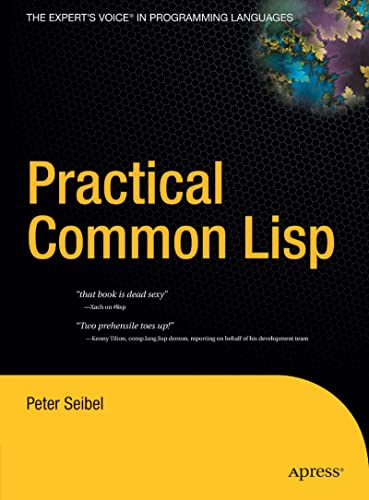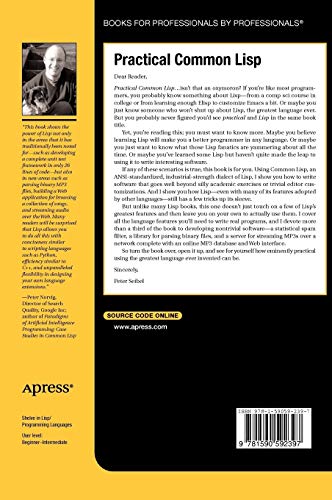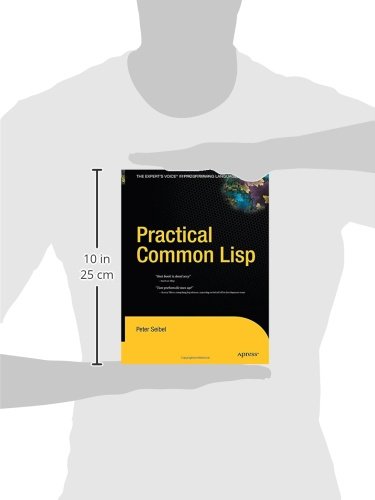



Practical Common Lisp (Books for Professionals by Professionals)
M**H
Aha - used books from Amazon!
I have only just discovered that you can get used books from Amazon, so I went this way to get a spare copy of Seibel's Practical Common Lisp - - a volume that any Lisp programmer will want to own at least one of - - but I didn't want to pay full price so I went for a used one. When it turned up I was smack mouthed to find a hardback, and in spanking condition too. Blimey. Brilliant.
P**D
Lives up to its title
Do not buy this book if you want to learn Lisp. Buy this book if you have gained some exposure to Lisp but doubt that it can be used to solve real world programming problems. I have dabbled with Lisp on and off for 20 years; this book has helped me with some basic issues that I could not grasp, for lack of suitable "real" examples. The approach is "bottom-up", so be prepared to wade through several chapters before you get to the meat, but you will learn many essential skills along the way. Definitely makes me a better Lisp programmer, and a keener advocate for the language.
M**G
An excellent way to learn Lisp
The book comes in two types, paperback and hardback. I bought the hardback version. This version has a thick board covers, with integral glossy image - there is no separate dust jacket. The image is mostly black with yellow lettering, also includes a subtle colour image. It is an attractive and well-printed book.The book is designed for beginners. It starts at the beginning, and make no assumptions about the reader - except, I suppose that the reader has a basic ability at programming. On the flip side, the book doesn't cover advanced techniques, which are mentioned in passing, but otherwise not dealt with.Common Lisp is an established language, and although the book is almost ten years old the text is almost up-to-date. The text suggests installing 'Lisp in a box'. This has now been superseded by 'Portacle'- presumably the next edition will address this. I tried to use a manually installed system of Emacs and Slime but it was missing a lot of the keyboard combinations.
L**A
My first and yet foremost guide to Common Lisp
The reason I started reading Practical Common Lisp was due to the need of learning the language because I was going to work at a company which uses Common Lisp as their main programming language. Being such a niche language this company gives a 40h course on Common Lisp by an expert and I couldn't attend it because I was still working in my previous job.Well, Practical Common Lisp did the trick and in a pleasant way. The writing style (discourse) of the author is really good and in parts entertaining (see the story introducing macros in the corresponding chapter), the coverage of the language is very well achieved for an introductory to medium level book and the practical parts are very good. I think that currently, even without having read any of the more advanced books on Common Lisp out there I'm very well equipped in relation to the majority of my colleagues who have gone the way of the course given by the company alone.A very good thing is the free availability of the book in the internet in HTML format. This allows you to have a light version of the book reachable with ALT + TAB while you're trying the code at the REPL. You may also "try" the book before buying it.Some points to notice:* The practical chapters which are dependant on AllegroServe won't work today (2011) with the portable version of AllegroServe which isn't maintained AFAIK.* The code doesn't work in all implementations of Common Lisp, but I used ABCL for a large portion of the book without problems. The more common implementations work (ACL, SBCL, CLISP, etc).
G**H
Fun programming book
If you have programmed before and found it boring you may still be pleasantly surprised by Lisp. Unlike most programming languages which are a necessary evil for getting what's in your head into the computer, Lisp is actually fun to program. If you install Emacs and SLIME as the book instructs you to and follow along you will have a lot of fun. Seibel shows you how to build practical applications which harness a lot of the power of Lisp. You will see how macros can be used to write clean, concise and efficient code which, despite what some parenphobes will tell you, is a lot easier to read than most other popular languages.Come with an open mind. Forget the lame jokes and stereotypes propagated by those who have never even seen Lisp let alone programmed it. If you want to be a serious programmer, do yourself a favour and get this book.
Trustpilot
1 month ago
2 months ago